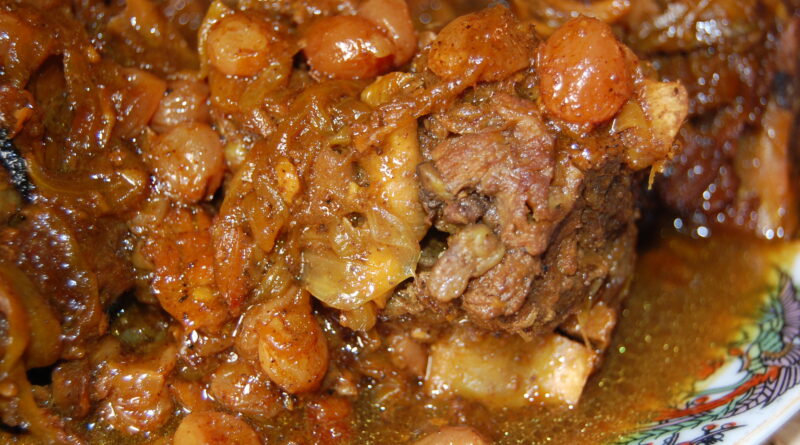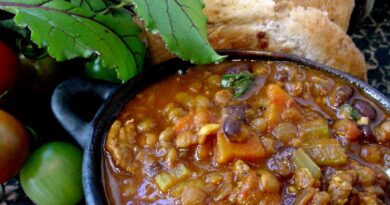Mrouzia
Exploring Mrouzia: Morocco’s Exquisite Festive Dish
Introduction: In the colorful tapestry of Moroccan cuisine, Mrouzia stands out as a dish that embodies the rich flavors, vibrant spices, and centuries-old culinary traditions of the region. This exquisite festive dish, loved by many across Morocco, is a testament to the country’s diverse cultural heritage and its deep connection to the land. In this article, we embark on a flavorful journey to uncover the origins, ingredients, preparation methods, and cultural significance of Mrouzia.
Origins and History: Mrouzia traces its origins to the imperial cities of Morocco, particularly Marrakech and Fes, where it has been enjoyed for centuries as a dish fit for royalty and nobility. Historically, Mrouzia was prepared during special occasions and celebrations, such as weddings, religious holidays, and other festive gatherings, symbolizing abundance, prosperity, and hospitality.
The name “Mrouzia” is believed to have originated from the Arabic word “marz,” which means “to marinate” or “to preserve.” This aptly describes the process of marinating the meat in a flavorful mixture of spices and honey, which gives Mrouzia its distinctive taste and aroma.
Ingredients: The key ingredient in Mrouzia is meat, typically lamb or beef, which is marinated in a fragrant blend of spices and honey. The spices used in Mrouzia vary depending on regional preferences and family recipes but often include a combination of cinnamon, ginger, saffron, turmeric, cumin, and paprika.
In addition to the spices, other ingredients such as onions, garlic, almonds, and dried fruits like raisins, apricots, and dates are also used to add depth and complexity to the dish. These ingredients come together to create a harmonious fusion of flavors, with each element contributing to the overall richness and complexity of Mrouzia.
Preparation Method: The preparation of Mrouzia is a labor-intensive process that requires patience, skill, and attention to detail. To begin, the meat is cut into large chunks and marinated in a mixture of spices, honey, and a small amount of water. The meat is then left to marinate for several hours or overnight, allowing the flavors to penetrate and infuse.
Once marinated, the meat is cooked slowly over low heat in a tagine or large pot, along with the onions, garlic, and any remaining marinade. The slow cooking process allows the meat to become tender and succulent, while also allowing the flavors to develop and intensify.
In the meantime, the dried fruits are soaked in warm water to rehydrate them before being added to the pot along with the almonds. This adds a touch of sweetness and texture to the dish, balancing out the savory and spicy flavors of the meat and spices.
Cultural Significance: Mrouzia holds significant cultural importance in Moroccan society, where it is cherished as a symbol of tradition, generosity, and communal feasting. It is a dish that brings families and friends together around the dining table, fostering a sense of connection and shared heritage.
In addition to its cultural significance, Mrouzia also holds symbolic value, particularly during religious holidays such as Eid al-Adha, where it is often prepared as part of the festive feast. It is a dish that evokes memories of celebrations past and reinforces the bonds of kinship and community.
Variations and Regional Differences: While the basic recipe for Mrouzia remains the same across Morocco, there are variations and regional differences that reflect the diverse culinary traditions of the country. In some regions, Mrouzia may be prepared with additional ingredients such as preserved lemons, olives, or hard-boiled eggs, adding depth and complexity to the dish.
In Marrakech, for example, Mrouzia is often served with a side of couscous or crusty bread, while in Fes, it may be accompanied by a traditional Moroccan salad or a dish of spiced chickpeas. These regional variations highlight the versatility of Mrouzia and the creativity of Moroccan cooks.
Conclusion: In conclusion, Mrouzia is more than just a dish – it is a celebration of Moroccan cuisine, culture, and heritage. From its humble origins to its cherished place on dining tables across the country, Mrouzia embodies the spirit of tradition, generosity, and shared identity.
Whether enjoyed as a simple family meal or as part of a festive feast, Mrouzia continues to captivate the senses and bring people together through its irresistible flavors and timeless appeal. So the next time you find yourself craving a taste of Morocco, be sure to seek out this culinary masterpiece and experience the magic of Mrouzia for yourself.



